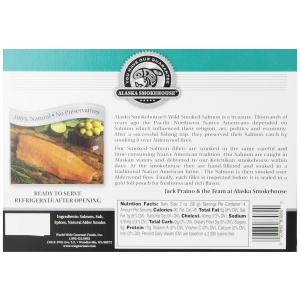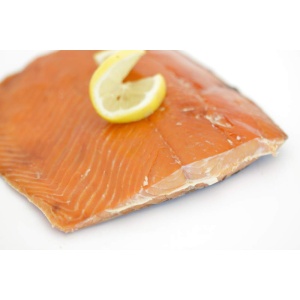Fish for Food Storage
Showing all 3 results
-
Alaska Smokehouse Jumbo Smoked Salmon (8 Oz), 3Count Variety Pack 8 Ounce (Pack of 3) – (SHIPS IN 1-2 WEEKS)
$86.99 -
Alaska Smokehouse Smoked Salmon, 8oz, 2 Pack – (SHIPS IN 1-2 WEEKS)
$62.99 -
Alaska Smokehouse Trio of Smoked Salmon/Pepper Garlic/Sockeye Gift Set 4 ounce each – (SHIPS IN 1-2 WEEKS)
$38.99
Why Fish are Great for Emergency Food Storage
 People all around the world love fish. Fish come in various shapes and sizes, and sometimes even various colors. It is great for eating by itself as a snack for a protein boost, mixing in with salads, pasta, rice, stir fry, or whatever else sounds good!
People all around the world love fish. Fish come in various shapes and sizes, and sometimes even various colors. It is great for eating by itself as a snack for a protein boost, mixing in with salads, pasta, rice, stir fry, or whatever else sounds good!
Fish are rich in the following vitamins and minerals: calcium, phosphorus, vitamin d, and vitamin b2 (riboflavin). They also contain smaller amounts of iron, zinc, magnesium, and potassium.
Raw fish nutrients will vary based on variety but in a fillet of fish , there are approximately 265 calories, 2 grams of fat, 119 milligrams of cholesterol, 101 milligrams sodium (salt), 0 grams of carbohydrates, 0 grams of dietary fiber, 0 grams of sugar, and 38 grams of protein.
Fish have a glycemic index of 0. The glycemic index is a scale of 0-100 that scores how quickly carbohydrates are converted into energy with zero being the lowest and 100 being the highest (pure glucose.) Foods with a lower glycemic index break down slower and give you smaller amounts of energy over a larger period of time.
Food storage of fish typically consists of a combination of any of the following: #10 cans, #2.5 cans, mylar pouches, glass or plastic jars, and pails or buckets. No matter the container you’ll likely find an oxygen absorber that you’ll want to discard once you open the product since they can’t be reused.
Freeze-Dried Fish
Fish that are freeze-dried retain much of their nutritional value. Freeze drying is most-advanced process of completely removing water from food. It uses low temperatures to freeze a food’s moisture content, and with the aid of a vacuum pump and gradually warming temperatures, removes the ice from the food by a process known as sublimation. The proper terms for this process, in whole, are lyophilization or cryodesiccation. In the past it required large, and very expensive commercial freeze drying machines. Much smaller and many times more affordable freeze dryers are now available for in-home use here.
Fish that are properly freeze-dried can have a shelf life of up to 25 years or more! It’s important that you keep them dry and in cool temperatures. Storing freeze-dried fish in places that can get very hot in the summer, such as garages and attics, will drastically reduce their expected shelf life. We suggest storing them in cool and dry places of 75 degrees Fahrenheit or lower. We suggest that when you open a package or can you’ll want to consume it all within 12 months.
Freeze-dried fish typically retain their same shape as when they were raw but become much lighter. A lot of people will describe them as crunchy. You can rehydrate freeze-dried fish by placing them in a bowl of water for several minutes. You’ll want to check them every so often to get them back to the consistency that you want. Once reconstituted we’ve experienced them tasting and having a texture as if them were placed in a freezer raw then thawed out. Whether you eat them dry or rehydrated, they are sure to please!
Dehydrated Fish
Fish that are dehydrated retain some of their nutritional content. Dehydration uses heat and higher temperatures to dry foods out. It’s use dates back to as early as 12,000 B.C. One of the oldest methods of dehydrating food is sun drying. Other methods include air drying, solar oven dehydrating, oven drying, and using at-home electric dehydrators.
The shelf life of dehydrated foods will vary based on many factors but it is typically limited to 3-5 years or less. Like freeze-dried fish we recommend storing dehydrated fish in cooler and dry locations to extend their shelf life as much as possible. You should consume them as soon after breaking their container seal.
Dehydrated fish will typically shrink and “shrivel” up and harden some extent. They are great for camping because they take up much less space (volume) than freeze-dried ones. You can rehydrate them with water but we don’t like them reconstituted as much as their freeze-dried counterparts. Despite that opinion of ours being said they are still delicious and are the perfect choice for many applications!
Freeze-Dried Fish vs. Dehydrated Fish
There are some key differences between freeze-dried and dehydrated fish in form, function, taste, and nutrition. You decide the winner!
| Fish | Freeze-Dried | Dehydrated |
|---|---|---|
| Volume | Similar to its raw state | Smaller and shriveled |
| Nutritional Value | Similar to its raw state | Some nutrients lost due to heat |
| Moisture Removal | Up to 99% | Up to 80% |
| Shelf Life | Up to 25 years or more | 5 years or less |
| Consumption Time Once Container Opened | Up to 12 months | Should consume ASAP |
| Color Retention | Very good | Darkening in many instances |
| Can be Rehydrated? | Yes | Yes |
Sources
https://doh.wa.gov/community-and-environment/food/fish/health-benefits
https://www.nutritionix.com/food/raw-white-fish
https://guidelines.diabetes.ca/docs/patient-resources/glycemic-index-food-guide.pdf
https://medlineplus.gov/ency/patientinstructions/000941.htm
https://en.wikipedia.org/wiki/Freeze-drying
https://nchfp.uga.edu/publications/nchfp/factsheets/food_pres_hist.html
*These statements have not been reviewed or approved by the FDA







